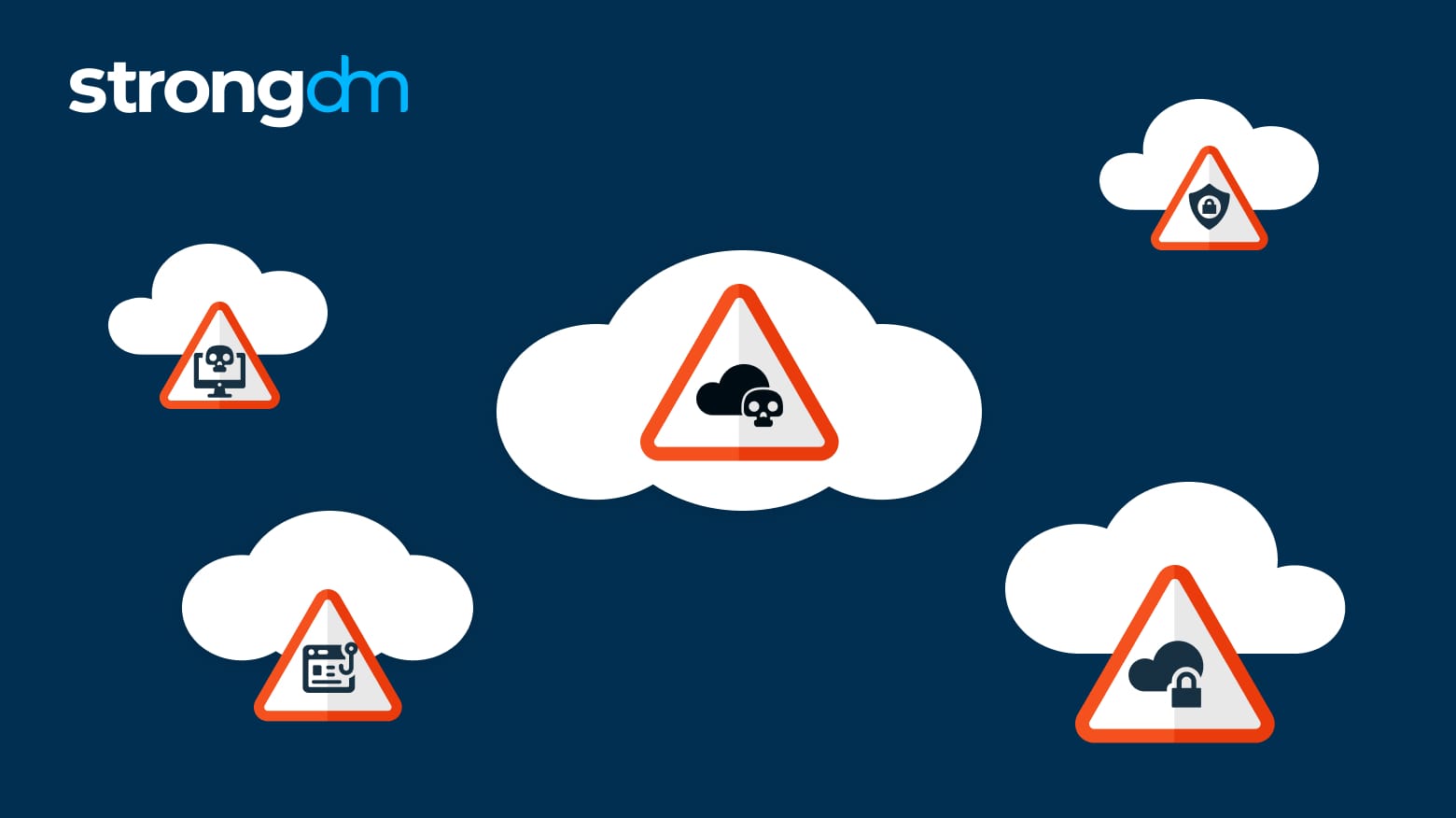The Top 8 Cloud Security Issues in 2022
Cloud computing offers an organization’s users the flexibility to access their resources and collaborate from anywhere. It’s also a cost-friendly solution that enables businesses to scale their technology capabilities based on their growth needs. Cloud computing provides unlimited storage capacity and quick deployment while requiring no costly hardware.
Because of these benefits, nearly 94% of enterprises now rely on cloud services to run their servers, host applications, and store critical data. While most organizations use a public, third-party cloud provider, many large businesses invest in the infrastructure and data centers needed to create their own private clouds. [1]
This increased popularity and reliance on cloud technology introduces a new wave of security challenges that traditional, on-premises security controls such as network firewalls cannot solve. [2]
Here are eight cloud security challenges organizations should consider when evaluating their platform options and current security posture:
1. System misconfigurations
Cloud infrastructure misconfigurations that occur during system setup and operation can unintentionally create vulnerabilities. These problems often result from common errors, such as when
- An organization inadvertently gives an entire enterprise group, such as an IT support team, unlimited privileged access to network resources
- A team uses a default set of easy-to-guess credentials for all users and resources to simplify the authentication process
Because infrastructure is complex and cloud systems require integrations and application programming interface (API) connections, misconfigurations can happen frequently. One report cited that nearly three-quarters of firms using Amazon Web Services (AWS) have at least one critical cloud security misconfiguration. [3]
2. Availability of cloud security experts
Cloud architecture and cloud security require specialized knowledge. Unfortunately, the availability of skilled labor in this field, particularly for specialists trained in managing security concerns in cloud computing, has not caught up to demand. Consequently, organizations must rely heavily on outside advisory and managed services to deploy, maintain, and secure their cloud resources.
3. Evolving beyond legacy security solutions
Adopting new technology, such as cloud services, requires organizations to incorporate new security frameworks and strategies. Cloud infrastructure lacks an established network perimeter. Resources run on servers stored in data centers spread around the world and can be accessed from anywhere.
Therefore, the traditional security model, which typically comprises a network firewall and on-premises network credentials, cannot sufficiently address the security issues with cloud computing. Businesses must evolve beyond legacy solutions and utilize Zero Trust Architecture, which considers the popularity of cloud-based resources, the need for remote system access, and the requirements for prioritizing security at the application level.
4. Securely incorporating open-source platforms
Because cloud computing offers ease of access, DevOps and security teams often favor open-source technology or free code. Both let businesses tailor applications or software components to their unique functionality and infrastructure needs. Though open-source code makes development and deployment much faster, it comes with its fair share of issues.
For example, open-source code is rarely certified by a cloud service provider, and there’s usually no official product support team to assist with development or integration issues. Weaknesses like these leave businesses more vulnerable to misconfigurations. Additionally, open-source code vulnerabilities typically get published on community forums—pages read by cybercriminals and hackers.
5. Identity and access management
Identity and access management (IAM), which involves using technology and policies to control which users may access what resources, presents a significant cloud security challenge. Cloud infrastructure requires a sophisticated system of granular control because users access resources primarily at the application or modular level.
In a cloud environment that has not enabled single sign-on (SSO), the system verifies each user for an individual application or a cluster of applications, rather than authenticating the user for the entire network. Companies must invest in technology and personnel to control and enforce user access, store identity credentials, and track activity for logging and system visibility.
6. Staying in compliance
Regulatory and industry data management requirements, such as the Health Insurance Portability and Accountability Act (HIPAA) and the Payment Card Industry Data Security Standard (PCI DSS), were created before cloud computing became popular. These requirements remain the same today, despite the paradigm shift to cloud storage and processing.
Besides ensuring that their own security governance policies and processes remain in compliance, firms that fall under compliance umbrellas must ensure their technology providers, including cloud services, meet the regulatory agencies’ data security requirements.
7. Managing the growing attack surface
Whether you’re using software-as-a-service (SaaS) or infrastructure-as-a-service (IaaS) platforms such as AWS, cloud-based systems add a plethora of new challenges to attack surface management (ASM). For starters, adding any endpoints, applications, servers, or databases to a network, by default, creates new points of entry and attack vectors for cyber criminals to exploit.
Adding network resources, specifically from third-party providers such as SaaS products, introduces new visibility issues. Let’s say, for example, a sales department subscribes to a customer relationship management (CRM) SaaS solution but fails to notify its IT support teams. That added application becomes a new attack vector within the network. The IT security department cannot monitor or secure it because it was never cataloged.
8. Creating an audit trail
A clean activity log with real-time user and resource data facilitates incident response management by helping security operations teams pinpoint breach sources and locations within the network and isolate them to reduce their impact. An auditing and reporting system also provides crucial data for organizations that must meet compliance requirements.
With the cloud, however, it’s challenging to centralize that flow of information. Businesses have network resources scattered all over the place, and cloud applications get provisioned outside of an IT management team. The consequence is reduced visibility and auditing capabilities for the enterprise.
The Top 6 Cloud Security Risks in 2022
Today’s cloud computing security issues and evolving cybercrime trends introduce new risks that create a need for solutions that can assist companies with prevention, detection, and response. Eighty-one percent of organizations sustained at least one cloud security threat last year, and 45% experienced up to four incidents during that same period. [4]
Here are six leading cloud security risks and threats to watch out for:
1. Online account hacking
Most cloud applications only require login credentials, typically a username and password, for authentication. This presents cloud computing security risks that would be much less concerning in on-premises environments or if contextual verification, such as the user’s location, were used.
Hacking schemes, such as phishing emails, can persuade users to divulge their credentials on what appears to be a trusted web page. Many users also struggle to manage their credentials properly, often constructing weak passwords or storing them in an insecure place. Practices like these leave users’ accounts vulnerable to brute-force attacks that, when successful, enable hackers to gain unauthorized access.
2. Zero-day attacks
Because many organizations use open-source software and invest in popular services such as AWS, Microsoft Azure, and Google Cloud Platform (GCP), it’s nearly impossible for any known vulnerability to go unexploited.
These weak spots create ample opportunities for hackers to launch zero-day attacks on cloud systems—attacks that target recently identified vulnerabilities before they’re patched. With these types of attacks, system administrators and developers have only a small window of time to perform software updates and system maintenance activities before the vulnerabilities can be exploited.
3. Insider threats
Without a robust IAM system that provides granular access control and modern network security—such as Zero Trust Network Access (ZTNA)—any trusted, authorized user can quickly become an organizational threat. As cloud applications and environments don’t always require local access, disgruntled employees and users who were improperly off-boarded could steal sensitive data or deploy malware attacks from the inside.
There’s also the whole negligence component of an insider threat. Even employees with the best intentions can unintentionally divulge their credentials, download malware to the network, or share sensitive files on a non-secure channel or without encryption.
4. Malware
One of the top benefits of cloud-based applications and services is simplicity. The cloud makes it easy to access and share resources. The downside, however, is that malware becomes more easily deployable. Files constantly travel inside and outside the cloud, giving threat actors more opportunities to penetrate a cloud environment and sneak in malicious code that will spread and harm other areas of the network.
5. Data loss
A significant risk of a cloud service, data loss can happen for a few reasons. In network extortion or ransomware incidents, a hacker encrypts an organization’s cloud-sourced data until the victim makes a payment. If the victim cannot pay the ransom, the hacker wipes the data completely. Data loss can also occur during system migration. A firm might make a costly error when moving to a new environment or backing up its current one.
Information sharing exposes organizations to the most common risks associated with data loss or compromise. As the cloud offers an easy solution for users to share files and applications with their peers or those outside the network, one negligent or intentionally malicious move could cause sensitive data to fall into the wrong hands.
6. Data-security non-compliance
Among the many cloud data security issues associated with managing compliance is the risk of non-compliance—an issue that carries legal exposure and has the potential to compromise a company’s reputation. Organizations that lack a method for vetting cloud providers and those whose security systems have not been configured to meet regulatory requirements can find themselves drenched in expensive fines and branded with a poor reputation for protecting their customers’ privacy.
How to Manage Cloud Security Issues and Risks Effectively
As many security risks of cloud computing occur at the application level, organizations must utilize a layered approach to security that protects applications and resources. For instance, enforcing multi-factor authentication (MFA) helps prevent user-account-based hacks by requiring an additional verification method, such as a biometric or a hardware device.
Continuous visibility and access management are other critical elements of cloud security. Firms can invest in Cloud Infrastructure Entitlement Management (CIEM) technology to automate and organize their threat detection, activity monitoring, and access management within multi-cloud and hybrid environments. CIEM helps teams apply granular permissions within a network, enforce the principle of least privilege, and prepare for compliance audits.
To prevent negligence incidents, companies should sponsor awareness training on phishing scams, credential management, and the handling of sensitive cloud data. Additionally, organizations should adopt solid governance practices, such as policies that enforce the use of strong passwords and procedures for regular cloud system backups, frequent access audits, and prompt updates or patches to software applications.
Zero Trust and cloud security
Zero Trust can be a savior for cloud security. This framework is specifically designed to mitigate risks associated with parameterless networks, frequent remote access, and cloud-based infrastructures. A Zero Trust strategy assumes that an enterprise is constantly at risk for a breach and must use layered security, continuous authentication, and incident isolation to protect itself.
For example, Zero Trust incorporates the principle of least privilege by giving users access only to the resources they need to perform their jobs. It also includes segmentation, which divides a network into modules or micro-networks by placing specific access control and authentication requirements at entry points. This enables firms to isolate incidents, such as malware attacks, to just one network area.
How StrongDM Helps Prevent Cloud Security Issues and Risks
StrongDM’s People-First Access Platform lets enterprises reap the scalability and flexibility of the cloud while mitigating cloud security risks. The platform integrates with top identity providers and serves as a granular access management system. These capabilities let teams control cloud resource access, securely manage user credentials for cloud-based accounts, and enforce the principle of least privilege within an organization.
StrongDM helps transition organizations from legacy security and access tools to Zero Trust Network Access (ZTNA) for cloud, multi-cloud, and hybrid environments. The infrastructure management solution ensures businesses can connect users to needed resources and works with popular cloud services, such as AWS, Azure, GCP, and Snowsight.
Additionally, centralized and automated observability is a breeze with StrongDM. The system lets security operations teams track and log database, website, and login activity for all resources in one interface. There’s also automated evidence collection for audit reporting and to ensure cloud infrastructures and organizational practices meet HIPAA, SOC 2, and ISO 27001 requirements.
Maintain a Solid Cloud Security Posture with StrongDM
Cloud computing has revolutionized how enterprises store their servers, applications, data, and other resources. It gives business users and development teams easy, high-speed access to their corporate network. IT departments gain tons of scalability potential with unlimited data storage. And security teams get granular access control, data loss prevention (DLP) solutions, and quick data recovery capabilities after an incident.
Despite its benefits, cloud computing comes with its fair share of cloud security concerns, including frequent misconfigurations, identity and access management issues, challenges around maintaining compliance, and the need for greater system visibility. It’s also difficult to find skilled experts who understand cloud security to manage systems internally. These issues can lead to risks such as cyberattacks, data loss, and insider threats.
StrongDM helps ease these concerns by providing end-to-end, centralized control of resource access, authentication, and infrastructure visibility. From there, teams can reduce their cloud security risks, stay in compliance, and transition to a Zero Trust Network Access system that mitigates cloud computing threats.
Ready to get started? Check out our infrastructure access management solution today with our 14-day StrongDM free trial.
About the Author
Schuyler Brown, Co-founder / CCO, began working with startups as one of the first employees at Cross Commerce Media. Since then, he has worked at the venture capital firms DFJ Gotham and High Peaks Venture Partners. He is also the host of Founders@Fail and author of Inc.com’s “Failing Forward” column, where he interviews veteran entrepreneurs about the bumps, bruises, and reality of life in the startup trenches. His leadership philosophy: be humble enough to realize you don’t know everything and curious enough to want to learn more. He holds a B.A. and M.B.A. from Columbia University.




